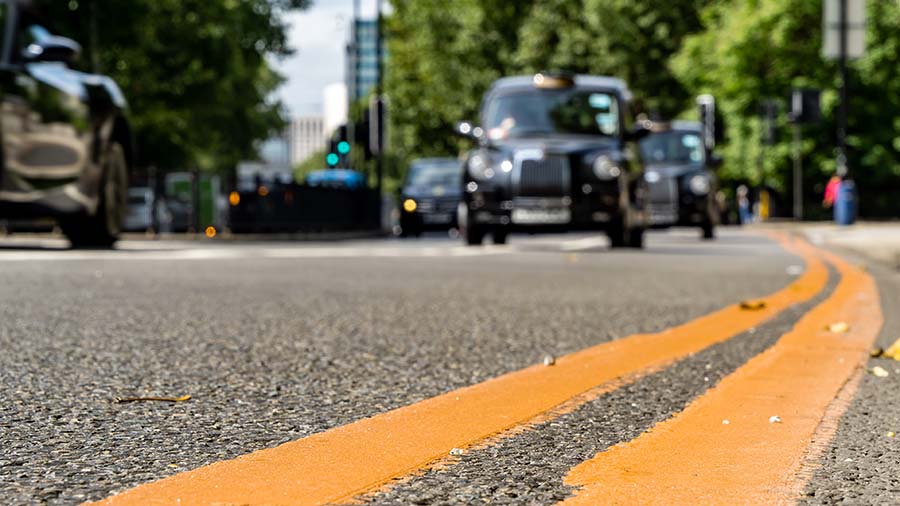Single Yellow Line: Your Guide to the Rules and Regs

With so many different road markings, it can be difficult to keep track of what they all mean. We’re going to take a look at one type that can cause a lot of confusion: the single yellow line.
What does it mean? How is it different from double yellow lines? What about red lines? And what’s the problem with just ignoring it altogether?
Find the answers to all those questions below. Let’s dive in.
What does a single yellow line mean in the UK?
In the UK, a single yellow line on the road tells you that parking is restricted. The restriction will apply at certain times of the day. Sometimes it’s active every day, and sometimes only on certain days.
Somewhere nearby, there’ll be a sign telling you when you’re not allowed to park. The sign will have a yellow background and a small version of the “no parking” sign on it. That’s a blue circle with a red edge and a red line through it. It looks like this:
The days and times the restriction applies will be written in black. Note that the times on the sign are the times when you can’t park.
When can you park on single yellow lines in the UK?
So when can you park on a single yellow line? The answer varies by location.
In some areas, parking might be permitted outside normal working hours, say, Monday to Friday, 8 am to 6 pm. But there’s no hard and fast rule here. It depends on how the road is used. To know when you can park, you need to find the sign that tells you.
This will be at the side of the road, usually near the single yellow line. If you’re there outside the times stated on the sign, it’s ok to park.
In Controlled Parking Zones, also known as CPZs, the sign may be further away from the yellow line. CPZs are used where the same parking rules apply over a larger area. And they prevent the need for lots of parking signs cluttering the street.
If you’re in a CPZ, there’ll be a sign at the point you enter or leave. It’s usually a white rectangular plate with the “no parking” sign at the top. The times and days the parking restriction applies will be shown in black text underneath.
How long can you stay on a single yellow line in the UK?
So depending on the time of day, parking on single yellow lines might be allowed. But how long can you stay there?
You’ll need to make sure you’ve moved your vehicle before the restricted parking period starts again.
If you’re lucky, that could be several hours. If you’ve arrived after the restrictions have ended for the day, you’ll be able to leave your car there overnight. Some restrictions apply on weekdays too, so if that’s the case, parking will be available over the weekend.
Just make sure you check the sign carefully. In some locations, there may be more than one period each day when the restrictions are in force. And if your car is there during the restricted times, you’ll be looking at a fine.
What is the difference between single yellow lines and double yellow lines?

In the UK, both single and double yellow lines mean that parking is restricted. But parking on double yellow lines is not allowed at any time.
And it won’t help you to mount the kerb! The Highway Code clearly states that the yellow lines apply both to the road and any pavement or verge alongside it.
What do red lines on the road mean?
You may also see double or single red lines along the side of the road. Parts of the road marked in this way are known as “red routes”.
The rules are similar to yellow lines, in that double lines mean the restriction applies at any time. If there’s a single red line, it applies only during the period specified on the nearby sign.
But here, it’s not just parking that’s prohibited, but stopping at all. Even pulling in for a few seconds — for example, to make sure the car boot is properly shut — is off-limits. Red routes are usually used in places where stopping the traffic flowing, even briefly, would result in major disruption.
There’s an exception to the no-stopping rule for disabled people in a vehicle displaying a Blue Badge.
And you may be able to stop to load or unload in designated bays. If the bay is outlined in white, you can stop at any time. If it’s outlined in red, there’ll be a sign explaining the days and times the bay can be used.
What happens if I park on a single yellow line?
If you park on a single yellow line during the period when parking restrictions apply, you’ll probably end up with a fine. These usually take the form of a Penalty Charge Notice (PCN). Traffic wardens and the police can also issue Fixed Penalty Notices (FPNs).
With a PCN, the amount you’ll have to pay will be set by the local authority in the area the offence occurred. In London, for example, the fine will be either £80 or £130. You’ll be slapped with the higher level if your vehicle is deemed to be causing an obstruction.
Most PCNs have to be paid within 28 days. Many councils offer a discount, usually 50 per cent, if you pay within 14 days.
If you’ve left your vehicle in a dangerous position, you may also receive three penalty points on your licence.
The rules around parking penalties differ depending on whether you’re in England or Wales, Scotland, or Northern Ireland. And there are different routes for placing an appeal too.
Does parking on a single yellow line affect my insurance?
Whether receiving a penalty for parking affects your insurance will depend on the seriousness of the offence. In most cases, parking on a single yellow line will simply result in a fine. And while that’s annoying, it won’t have any impact on your insurance premiums.
But more serious parking infringements, like leaving your vehicle in a dangerous position, could land you with points on your licence. And it’s those points that will increase the amount you have to pay for insurance.
Does a single yellow line mean the same thing overseas?
The rules set out here apply to single yellow lines along the edge of the carriageway in the UK, Ireland and the Isle of Man. But as with so many rules of the road, things are different in other countries.
If you’re driving abroad, get hold of a guide that covers the basics before you travel. And if you see any signs or road markings you don’t understand, don’t assume the meaning is the same as in the UK.
Here are a few examples of the different things a single yellow line can mean overseas:
Malta: no waiting at any time, but you can stop briefly to drop off and pick up passengersAustralia: no stoppingCanada: used to separate lanes of traffic travelling in opposite directions. Passing is allowed, but only with extreme careUSA: used to mark the left side of the lane closest to the central reservation, or the left side of the left-most lane on a one-way ramp
The dos and don’ts of the single yellow line
If you’ve been asking yourself, “Can I park on a single yellow line?” the answer is yes. But it all depends on when you’re doing it.
Look for the sign that sets out when parking is restricted. It will usually be yellow and at the side of the road somewhere close by.
If you can’t spot a yellow sign, you’re probably in a Controlled Parking Zone. There’ll have been a white sign when you entered explaining what time the parking restriction is in force.
Don’t be tempted to ignore the yellow line and hope for the best! Parking penalties can be a costly business. And if you’ve made a mistake and parked where you shouldn’t have, you’ll probably be able to save yourself some money by paying up promptly.
Also read:
Do parking tickets affect insurance?
Would you pass your Driving Theory Test in 2022? Find out!
How to help a learner driver in your family


